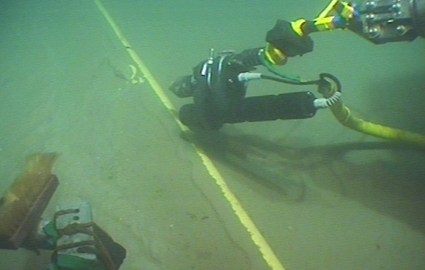Technical Paper
The Deficiency in data from trailing-wire / Tow-fish cathodic protection surveys
by James N. Britton (2000)
Abstract
This paper describes the common models and configurations of trailing wire surveys for offshore pipelines and their relative deficiencies, both functional and fiscal, when compared to a modified trailing wire configuration such as the "CP Snake."
Introduction
This paper provides some examples of how offshore paint systems in atmospheric service fail to deliver protection for their full life expectancy. For this study, we have selected two typical fixed drilling/production platforms in the Gulf of Mexico as case histories. Both deck facilities were fabricated on the US Gulf Coast at different fabrication yards. The jackets and decks were actually set in place in June of 1997. Our investigation was performed in November of 1998; the facilities had been offshore for only 17 months at the time of inspection.
The table below compares the critical elements of the two methods:
| PARAMETERS | TRAILING WIRE/TOW FISH | CP SNAKE |
| Proximity of Reference Electrode to Pipeline | Hard to verify | Electrodes are on bottom and directly over pipeline when data is logged. |
| Verification of Electrode Position | Varies with contractor, but may include on-line Pressure Transducer and Gradiometer | Magnetometer, Depth Sensor, Electric Field Gradients, Real Time GPS. |
| Number of Electrodes Compared | 1 or 2 | 5 |
| Wire Handling | Often discarded or lost in the ocean | No wire used, nothing wasted |
| Calibration Method | None | Periodic subsea contacts to calibrate remote potential |
| Survey Progress | Attempt to follow line or run "s-pattern" over line. | Designed lateral passes across line at intervals |
| Spread Required | Small boat with winch and wire handling system | Small boat with winch |
| Data Logged | Electrode vs. Trailing, WireTow Fish Electrode vs. Remote (Some Operators), GPS (only X-Y coordinates), Depth of Sensor, Pipeline Magnetic Field. | Close vs. Remote Electrode Potential Variation, Coarse & Fine Electric Field Gradients, Snake Depth, Pipeline Location GPS. |
*Direct comparison of cost of the two methods depends on a number of variables, but the cost of the CP Snake method will usually be within +/- 10% of the trailing wire technique, assuming that the same boat and number of operators is used, and the same requirements for system calibration are specified.
Methodology - Trailing wire / Tow fish
Some operators have started to use a remote electrode, but the problem is keeping the tow fish "close electrode" anywhere near the pipeline. Environmental concerns over disposal of copper wire into the ocean have also recently become another concern. The survey route is usually a zigzag over pipeline.
Methodology - CP Snake survey
The CP Snake is dragged directly on the sea floor and has special systems on-board to indicate when pipe is crossed. The survey pattern is made with lateral passes, at as close to 90 degrees as possible - no trailing wire is needed. If conducted correctly, the CP Snake passes laterally over the pipeline.
Deepwater Corrosion Services Inc. and the CP Snake
Deepwater has been in the offshore pipeline survey business since the mid-eighties. In that time, every request we have received to perform a trailing wire / tow fish survey was declined. The company never felt comfortable with the accuracy of the data, given that it was hard for us to verify that we had our measurement system on the pipe, or at least on the seabed immediately above the pipe. We therefore confined our activities to more costly ROV / Diver assisted surveys, many times to the detriment of our survey department's bottom-line (consequently we now no longer offer pipeline survey, referring the work elsewhere).
In 2000 we were commissioned by a customer to develop a suitable survey method for a pipeline in Cook Inlet, Alaska. After much deliberation, even considering trailing wire methods, we arrived at the solution. The CP Snake has now been proven in many areas of the world as the newest low cost survey method. Deepwater Corrosion no longer offers pipeline survey services with the CP Snake in the US, but the system is available from Subspection Ltd in the UK. Projects in other areas, please contact us.
CP Snake: System advantages
1. Costs equivalent to trailing wire type surveys.
2. Electrode is a close as physically possible to the pipeline under survey.
3. Additional internal instrumentation confirms pipeline has been crossed.
4. If pipe location isn't verified, data are not reported.
5. No copper wire discarded into the ocean, no stoppages due to wire breaks.
6. Electric field gradients give additional useful information.
** Deepwater is retiring its CP Snake pipeline survey system This method and the equipment developed are no longer available through any subsidiaries, agents, or affiliates. The technology and the trademarks associated will be retained by Deepwater, not for use by any unauthorized entities. Development info and the theory behind the system's development will remain available for educational purposes only in our online technical library.
This decision is made based on the lack of ability to get repeatable survey data between calibration contact points. The system will be replaced by the Polatrak® Pipe Reader System, which is presently undergoing field trials.
For info or concerns about the CP Snake survey method, please contact us.
Want to receive an email when Deepwater publishes new corrosion-related technical papers, case studies, and more? Sign up for our Corrosion Newsletter using the form below. You can unsubscribe at any time.






